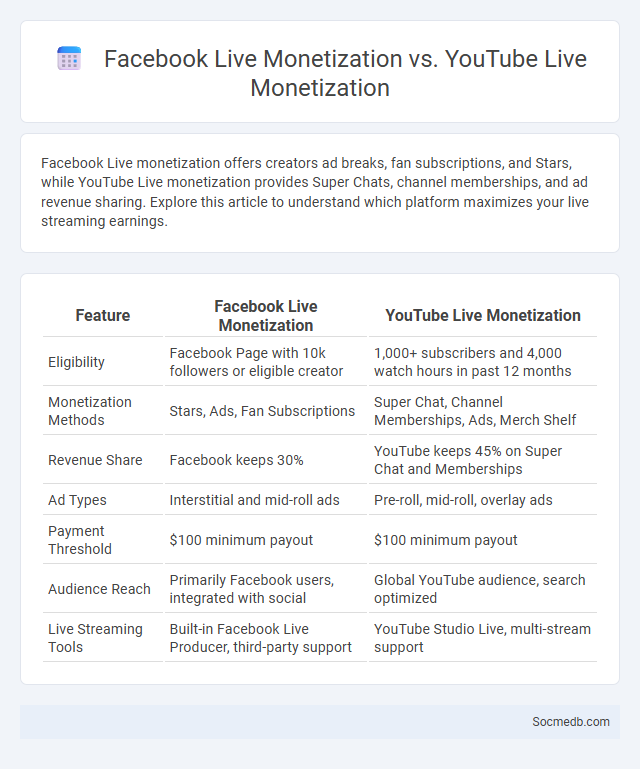
Photo illustration: Facebook Live Monetization vs YouTube Live Monetization
Facebook Live monetization offers creators ad breaks, fan subscriptions, and Stars, while YouTube Live monetization provides Super Chats, channel memberships, and ad revenue sharing. Explore this article to understand which platform maximizes your live streaming earnings.
Table of Comparison
| Feature | Facebook Live Monetization | YouTube Live Monetization |
|---|---|---|
| Eligibility | Facebook Page with 10k followers or eligible creator | 1,000+ subscribers and 4,000 watch hours in past 12 months |
| Monetization Methods | Stars, Ads, Fan Subscriptions | Super Chat, Channel Memberships, Ads, Merch Shelf |
| Revenue Share | Facebook keeps 30% | YouTube keeps 45% on Super Chat and Memberships |
| Ad Types | Interstitial and mid-roll ads | Pre-roll, mid-roll, overlay ads |
| Payment Threshold | $100 minimum payout | $100 minimum payout |
| Audience Reach | Primarily Facebook users, integrated with social | Global YouTube audience, search optimized |
| Live Streaming Tools | Built-in Facebook Live Producer, third-party support | YouTube Studio Live, multi-stream support |
Introduction to Live Streaming Monetization
Live streaming monetization transforms your real-time video content into a reliable revenue source through diverse methods like viewer donations, subscriptions, and sponsored content. Platforms such as Twitch, YouTube, and Facebook offer integrated tools enabling creators to optimize earnings by engaging audiences interactively. Understanding these monetization strategies empowers you to maximize financial returns while growing your social media presence effectively.
Overview of Facebook Live Monetization
Facebook Live monetization allows content creators to earn revenue through features like Stars, where viewers purchase and send virtual gifts during live broadcasts. You can also generate income via in-stream ads, which are short ads inserted into your live streams. Leveraging Facebook's vast user base, these monetization tools provide a scalable way to turn your live content into a consistent revenue stream.
Overview of YouTube Live Monetization
YouTube Live monetization enables creators to earn revenue through features like Super Chat, Channel Memberships, and ad revenue during live streams. Your channel must meet YouTube's Partner Program requirements, including 1,000 subscribers and 4,000 watch hours in the past 12 months, to access these monetization tools. Maximizing earnings involves engaging your audience in real-time and utilizing multiple revenue streams available on the platform.
Monetization Features Comparison
Social media platforms offer diverse monetization features such as Facebook's ad revenue sharing and Instagram's branded content tools, enabling creators to earn via ads and partnerships. TikTok's Creator Fund and YouTube's Super Chats introduce direct fan contributions, while Twitter's Tip Jar and subscription options provide alternative income streams. Effective monetization depends on platform-specific algorithms and user engagement metrics, making the choice critical for maximizing revenue potential.
Eligibility Requirements for Each Platform
Each social media platform enforces specific eligibility requirements based on user age, geographic location, and content guidelines to maintain a safe and compliant environment. For example, Facebook and Instagram require users to be at least 13 years old, whereas platforms like TikTok have regional variations in minimum age and content restrictions. Understanding these criteria is essential to ensure Your account setup adheres to platform policies and avoids potential suspension.
Revenue Streams: Ads, Donations, and Subscriptions
Social media platforms generate significant revenue through ads by targeting specific user demographics with personalized content, maximizing engagement and advertiser ROI. Donations have become a growing revenue stream, especially on content creator-driven platforms, where Your support enables creators to sustain and expand their work. Subscription models offer exclusive content or ad-free experiences, providing predictable monthly income and enhancing user loyalty.
Audience Engagement & Growth Opportunities
Maximizing audience engagement on social media requires creating interactive content that resonates with your target demographic and encourages meaningful interactions such as comments, shares, and likes. Leveraging analytics tools helps identify growth opportunities by tracking user behavior and preferences, enabling you to tailor your strategy for expanding reach and fostering a loyal community. Your consistent focus on personalized content and active communication can significantly enhance engagement rates and accelerate follower growth across platforms.
Payout Structure and Processing
Social media platforms typically implement a tiered payout structure based on content engagement metrics such as views, likes, and shares, ensuring creators earn proportionally to their audience reach. Your earnings are processed through automated systems that consolidate revenue from ads, sponsorships, and platform incentives, with payments often issued monthly via direct deposit or digital wallets. Understanding these payout schedules and processing methods helps you optimize your content strategy for maximum financial return.
Advantages and Challenges of Each Platform
Facebook excels in community building and targeted advertising, offering robust tools for businesses to reach specific demographics; however, it faces challenges with privacy concerns and misinformation. Instagram provides strong visual engagement and influencer marketing opportunities but struggles with algorithm changes impacting content visibility and issues related to user mental health. Twitter enables real-time news dissemination and public discourse, yet it grapples with content moderation difficulties and the spread of misinformation.
Choosing the Best Monetization Platform for Creators
Choosing the best monetization platform for creators depends on your content type, audience size, and engagement level. Platforms like Patreon offer subscription-based support, while YouTube enables earning through ad revenue and Super Chats. Evaluating factors such as payout rates, platform fees, and community guidelines helps maximize your social media income potential.
 socmedb.com
socmedb.com